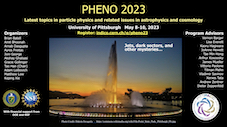Speaker
Description
Black hole superradiance is a phenomenon in which, purely through gravitational interactions, light bosons are spontaneously produced outside spinning black holes. Through this effect, an exponentially growing Bose-Einstien condensate cloud forms around the black hole. In the case of dark photon superradiance, the cloud can form into strings of magnetic flux analogous to Abrikosov vortices in type II superconductors. Once formed, these strings are ejected from the black hole as loops of flux in a "stringy bosenova" event and travel across the galaxy at relativistic speeds. We discuss the prospects of detecting such a string here on earth. In particular, we consider the effect of a broken $U(1)_{B-L}$ gauge boson string passing through gravitational wave detectors such as LIGO and MAGIS. We show that the effect of the string on the detector is independent of the gauge couping, $g$, and argue that, in some regions of the parameter space, these strings can produce a noticeable signal in the detector.
